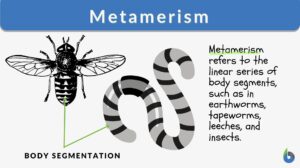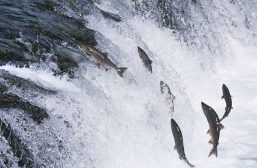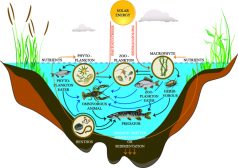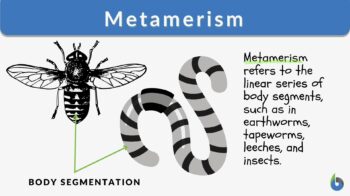
Metamerism
n., plural: metamerisms
[mɪˈtæməˌrɪzəm]
Definition: a linear series of body segments
Table of Contents
Metamerism Definition
Metamerism is the repetition of homologous body segments. This type of development can be seen in the Annelids, which include earthworms, leeches, tubeworms, and their relatives. It is also seen in a more advanced form in the Arthropods, such as crustaceans, insects, and their relatives.
What is metamerism? Metarism is a biological occurrence in which growth occurs by the formation of linear and fundamentally similar structures. However, all the structures (also known as segments) are not exactly similar. The difference in structures is due to the function they perform such as digestion or breathing etc. In plants and animals, metameric segments are called metamers. More precisely, an animal that has a segmented body, each segment is called somites and in plants, they are also known as phytomers.
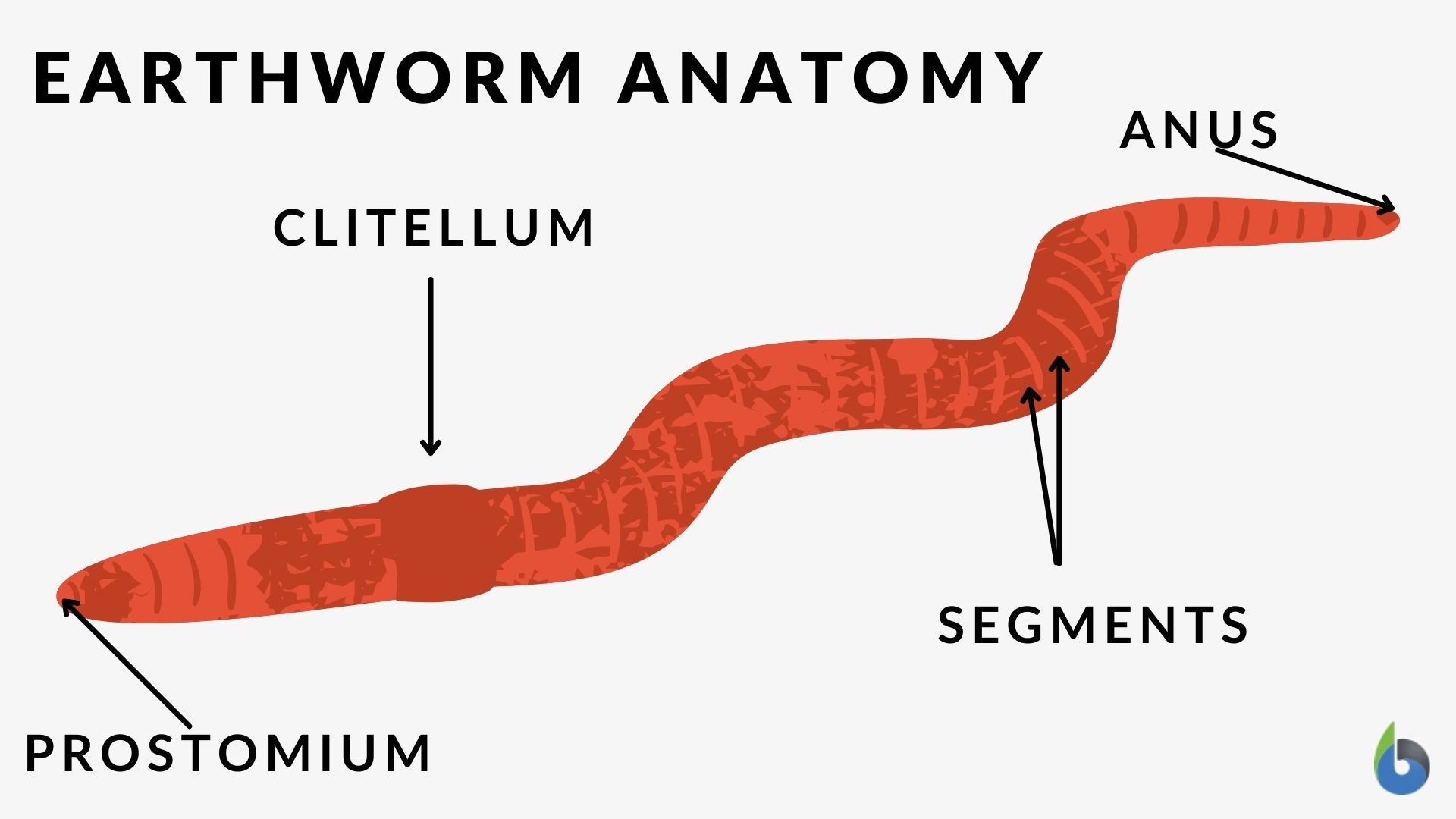
Metamerism in Animals
Metamerism has a significant biological importance when it leads to metamers, which can also be defined as somites. They are significant because they perform a vital role in advanced locomotion.
There are two main categories of metamerism: homonomous and heteronomous.
Homonomous metamery
In homonomous metamery, there is a strict serial succession of body parts, i.e. metamerism. It can be classified into two major categories, which are known as “true metamerism” and ”pseudo-metamerism”. The explanation of these two categories are given below:
| Table 1: True Metamerism vs. Pseudo-Metamerism | ||
|---|---|---|
| True Metamerism | Pseudo-Metamerism | |
| Definition | In true metamerism, the parts of the bodywork collectively work for the entire organism. | In pseudo-metamerism, the repeated part of the body may perform the independent task from each other. |
| Coordination | In true metamerism, the segmented body parts are well coordinated. | In pseudo-metamerism, there is zero coordination between the fragments. |
| Examples | Earthworms (annelids) | Tapeworms (Cestoda) |
In the annelids such as earthworms, all the body segments work together but such coordination does not happen in the tapeworms (Cestoda). It is said that one of the main reasons for segmentation is locomotion.
For Example: in the earthworm, muscular tissue segmentation causes the movement in the worm in an inching way. The circular muscles elongate while there is a shortening in longitudinal muscles. This pattern continues and thus assists in the movement on the surface. Although each segment works independently, the ultimate goal is the movement of the worm.
Heteronomous metamery
In heteronomous metamerism, the metameres are combined to perform the same task. In insects, 5, 3, and 11 metamers are in its head, thorax, and abdomen, respectively, and this is a pure example of heteronomous metamerism. The process in which all the groups of metamers are combined is known as tagmatization. The single group is called tagma (plural: tagmata).
In some organisms like insects, which have highly derived tagmata, most of the metamerism in tagma might not be distinguished easily. It is in such a structural form that does not show group metameric function.
For Example: Somites or the nervous system does not replicate the unitary structure of the thorax.
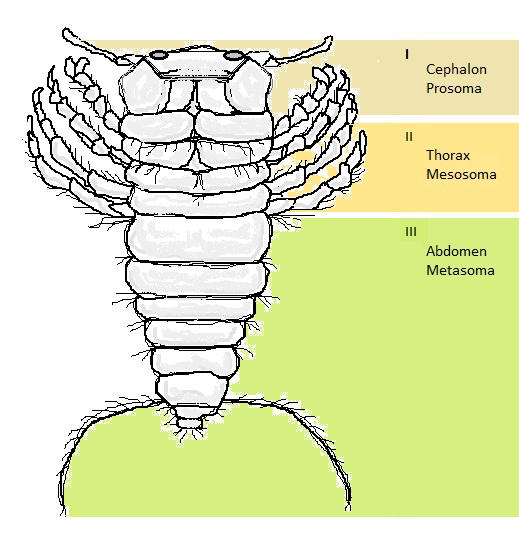
Metameric segmentation
In this, in the body of an animal, there is the repetition of tissues and organs in a regular interval. The body is thus divided into identical segments in a linear series. These segments are called metameres. It is most commonly found in Annelida. It is internal and mesodermal. The main segmental divisions are body musculature and coelom.
There is an internal segmentation of excretory organs, nerves, and blood vessels. The external segmentation is visible in some metameric animals, but in most animals like Chordata, external segmentation cannot be seen. In the embryo stage, internal segmentation is remarkably visible. It is thought that metameric segmentation comes as an adaptation for effective locomotion.
Chordata segmentation
In chordates, segmentation is carried through the process of somitogenesis. In this, there is the development of a pair of somites on each side of the midline.
Clock and Wavefront Model is used to describe the segmentation in chordates. This “clock” is considered as the episodic oscillation of defined genes like Her1, a hairy/Enhancer of split-gene. Its expression initiates at the posterior side of the embryo and travels at the anterior side. The site where the somites matured is considered as “wavefront”. It is the gradient of FGF and at the lower end of the gradient, somites develop.
Metamerism in Plants
A metamer is referred to as one of the numerous segments that take part in the construction of a shoot or into which a shoot may be resolved. In the metamerism model of the plant, there are many “phytomers” or “phytons”. Each phyton comprises an internode at its upper margin with the leaf.
Plants like grass have a clear and visible metameric construction. In other plants, no discrete modules were found and they are also under research.
In vascular plants, the shoot system shows metameric construction but not the root system. In the shoot system, there are repeated units of leaf, inflorescence, and stem. In seed plants or spermatophytes, the embryo of the plant shows the first metamer of the shoot.
Characteristic Features of Metamerism
Below are the features of metamerism:
- Except for the anterior acron and posterior telson, metamerism is always restricted to the intermediate segments.
- Every metamer shows an exact copy of the other.
- Segmental structures are inter-reliant on one another.
- They are combined as a single functional unit.
- All the body segments work in harmony and coordination.
Other Types of Metamerism
Apart from those discussed above, the other types of metamerism are as follows:
- external metamerism vs. internal metamerism
External Metamerism: this form of metamerism is observed in arthropods. There is no partition in the internal segments.
Internal Metamerism: there is internal metamerism in vertebrates. It is visible in the embryo and it is limited to the nervous, muscular and skeletal system.
External and internal metamerism: metamerism in Annelids is clearly visible both externally and internally. Internally they are marked by separations (septa) on the body and externally a constriction mark represents external metamerism.
- complete metamerism vs. incomplete metamerism
Complete Metamerism: when the segmentation is visible on all systems it is termed complete metamerism. Example: annelids.
Incomplete Metamerism: metamerism is termed incomplete when it is not visible on all body organs. Examples: Chordates and Arthropods
Theories of Metamerism
Why do some living things exhibit metamerism? Here are some of the theories that postulate the evolution of metamerism.
Pseudo-metamerism theory
The theory suggests that metamerism evolved secondarily to the repetition of body parts. It evolved from the unsegmented and acoelomate ancestors. They have several organs and systems which are spread along the entire body length. This is referred to as pseudo-segmentation.
This hypothesis is explained by the example of turbellarians. Turbellarians had yolk glands, testes, and transverse connective tissues of two nerve cords. The cords are repetitive along the entire body length and septa cause the separation in organs.
Cyclomerism theory
In 1884, Sedgwick Adam (Sedgwick, 1884) presented this theory. In 1950 and 1963, it was supported by Remane A.. It was thought that from the gastric pouch of some ancestral anthozoan coelenterates, coelom originates. There is a separation between the gastric cavity and gastric pouches and the arrangement is linear. In protocoelomates, the pouches are converted into coelomic pouches. In ancestral medusoid coelenterates, four gastric pouches are formed. Additional separation of two pouches results in the formation of three pairs of coelomic cavities which are protocoel, mesocoel, and metacoel.
Corm or Fission theory
This theory proposed that incomplete separation leads to metameric segmentation. This happens in two ways. First, when there are repetitive transverse separations in a non-segmented antecedent, and second is the formation of a chain of zooids or sub individuals from asexual reproduction. The zooids are combined from one end to the other. An example of this is platyhelminthes or scyphozoan strobilae.
Locomotion theory
To describe the origin of metamerism, R. B. Clark presented the locomotion theory (Clark, 1960). This theory states that in annelids metamerism comes as an adaptation for burrowing and for peristaltic locomotion. In peristaltic locomotion of annelids, there is lengthening and shortening of the body and longitudinal and circular muscles. The locomotion is carried out by the coelomic-filled fluid which acts as a hydrostatic skeleton. Peristaltic movement cannot become possible if the septa do not develop compartments. In chordates, metamerism is linked to strong serpentine, undulatory swimming.
Try to answer the quiz below to check what you have learned so far about metamerism.
References
- R. B. CLARK, M. E. CLARK; The Ligamentary System and the Segmental Musculature of Nephtys. J Cell Sci 1 June 1960; s3-101 (54): 149–176. doi: https://doi.org/10.1242/jcs.s3-101.54.149
- Sedgwick, A. (1884). On the origin of metameric segmentation and some other morphological questions.
©BiologyOnline.com. Content provided and moderated by Biology Online Editors.

